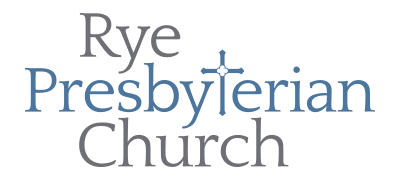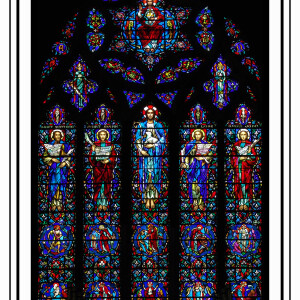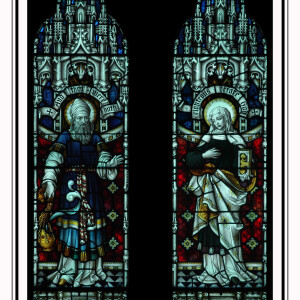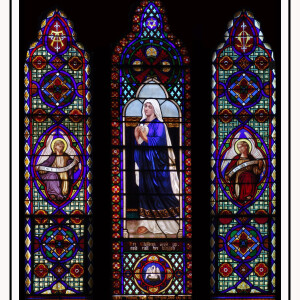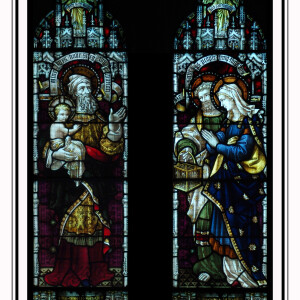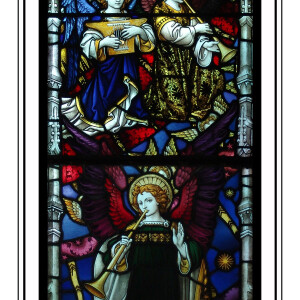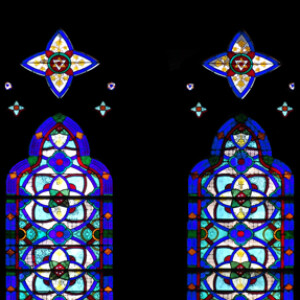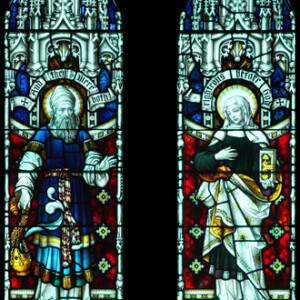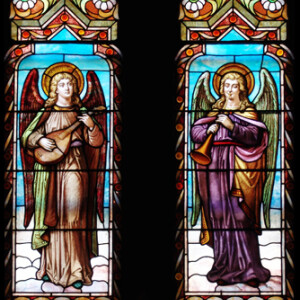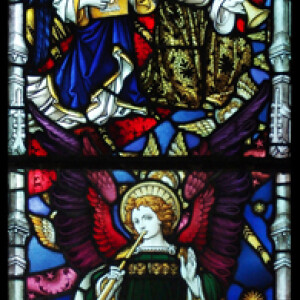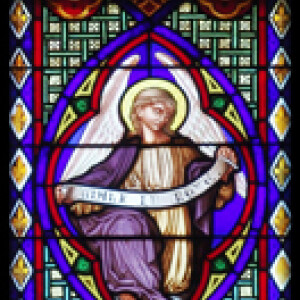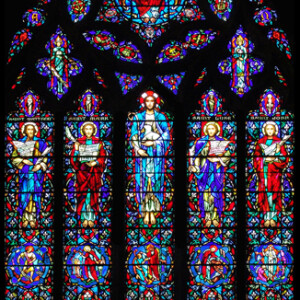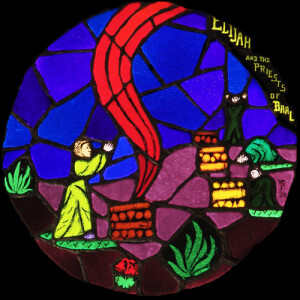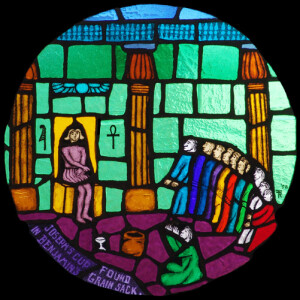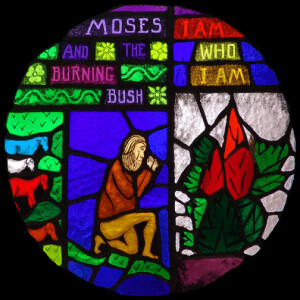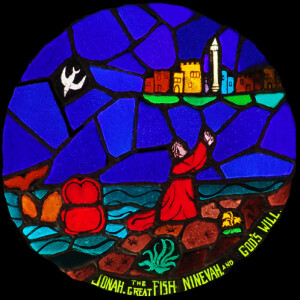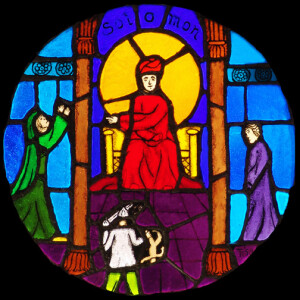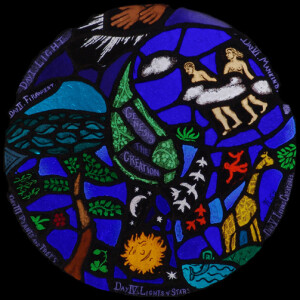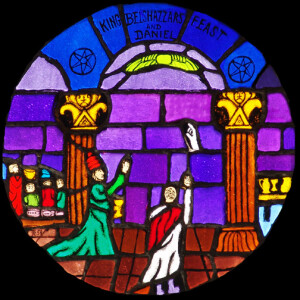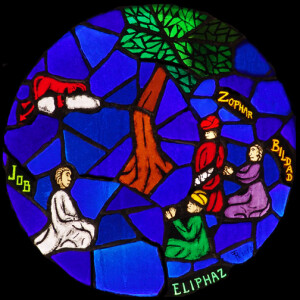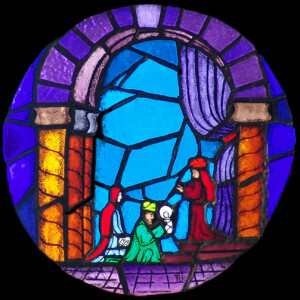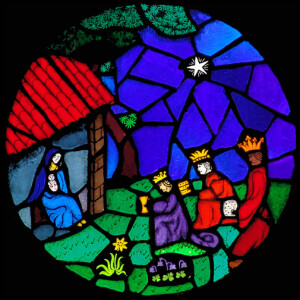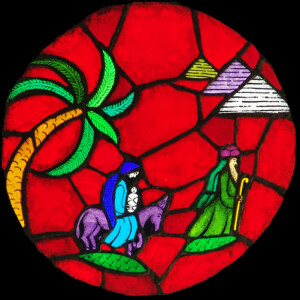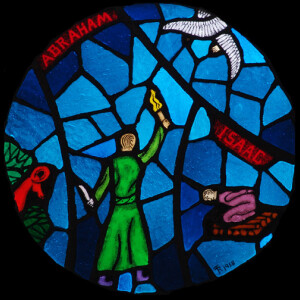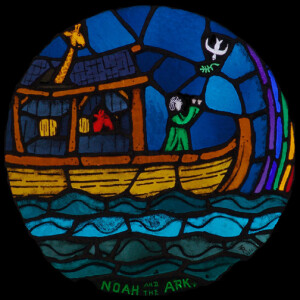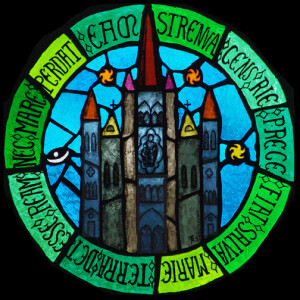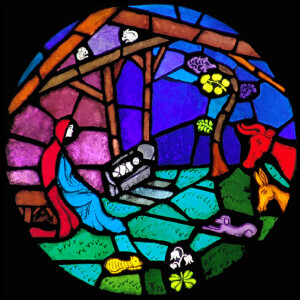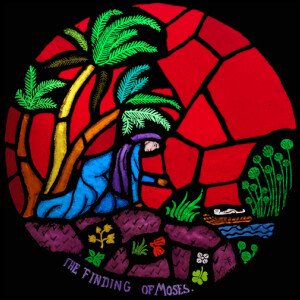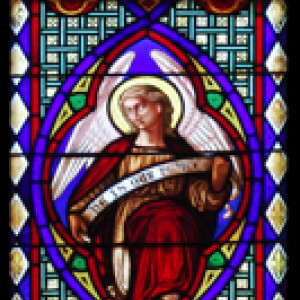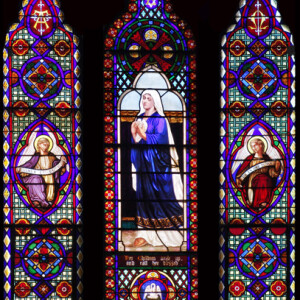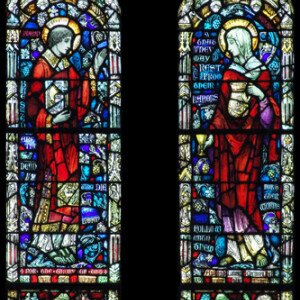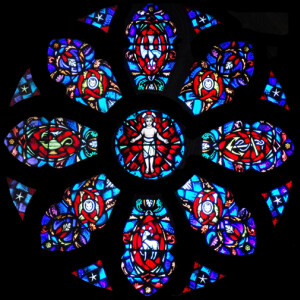RPC Stained Glass
Following is a history of our stained glass windows - a remarkable collection of American and English stained glass given by old Rye families: Clark, Mathews, Parsons, Van Rensselaer, Whittemore, and Corning. The collection, spanning a 75-year period, is remarkable not only for the craftsmen who designed the windows, but for those who gave them. Following this history, you can take a visual tour of some of the windows.
The first windows: The original 1870 lancet windows on the main floor as well as on the clerestory level were identical, with diagonally placed panels etched with fleur-de-lis designs and bordered with rich blues and reds. At the end of the south transept, two young children of Mary and John Parsons are memorialized in the “Good Shepherd” window; at the end of the north transept, Matilda Clark Parsons (1807-1858) is remembered in the “Mary with Offering” window. At the west end of the nave, a geometrically-designed window memorializes Eliza Jane Lyon Lord (1792-1840). They were thought to have been executed and installed by the New York firm of Sharp & Colgate in 1872. Over the next seventy years the gifts of five previously mentioned Rye families, related by marriage, began replacing the original main floor lancet windows.
Aquila & Prisca: To the right of the center aisle (south wall) beginning nearest the steeple tower is a set of windows by Henry Lee Willet that memorialize William H. Mathews (1817-1881) and his wife Eleanor Graham Finney. These were installed in 1932 at the direction of their daughter, Isabelle Mathews Corning. She, in turn, was memorialized in another window from the Willet firm, “The Twenty-third Psalm,” seen in the present library. This window was given in 1933 by her second husband, Arthur W. Corning.
Paul & Timothy: The second set of windows on the south wall, Paul and Timothy, also was crafted by Henry Lee Willet, son of founder William Willet (1868-1921), and a personal friend of Arthur Wellesley Corning (1865-1936), whom the window commemorates. This window was given in 1938 by Corning’s second wife. Corning was a great-grandson of Ebenezer Clark (1768-1847) whose marble memorial can be seen to the right of the pulpit.
Presentation of the Infant Jesus in the Temple: This third set of windows was executed by the English firm of Heaton, Butler & Bayne, a firm noted for its windows in the chapel of King’s College, Cambridge, England. It was given in memory of Arthur Wellesley Parsons (1809-1888) and Catherine Clark, a daughter of Ebenezer Clark. Miss Emma Parsons, Arthur’s sister, donated it in 1897. Catherine’s sister, Eliza Clark (1800-1888), is memorialized by the bronze wall tablet beside this window.
Narthex Window: To the left of the center aisle (north side) beginning in the narthex is a set of windows dedicated in 1893 in memory of Margaret Field Campion (1825-1892), nurse to a handicapped daughter of W. H. Parsons. The maker of this Tiffany-styled window has not been identified.
Philip & Dorcas: The next set of windows memorializes Edward P. Whittemore (1836-1899) and his wife, Caroline Loder. Whittemore was a grandson of Ebenezer Clark and son of the Rev. Williams Howe Whittemore (1800-1885) whose memorial tablet can be seen on the same wall. Charles J. Connick executed this window in 1928. It depicts the deacon, Philip, and the early disciple named Dorcas.
Zechariah & Elizabeth: The third set of windows depicts Zechariah and Elizabeth and was thought to be crafted by the English firm of Clayton & Bell, a distinguished firm responsible for the St. Cecilia window in St. Paul’s Cathedral, London. It was given in 1914 in memory of Jasper Edward Corning (1827-1913) and his wife Anna Matilda, granddaughter of Ebenezer Clark.
Archangels - Michael & Gabriel: The fourth set of windows was removed in 1956 and reinstalled in the chancel of Crawford Chapel. The firm of Heaton, Butler & Bayne designed these in 1911 to memorialize Miss Mary Parsons (1838-1909) the organist of Rye Presbyterian Church for twenty years.
Sarah and Abraham: Prior to 2020, to the left of the chancel was a window depicting the risen Jesus with several of his disciples. This east-facing window was given in 1924 by Mrs. Frank Washburn in memory of her husband (1860-1922). It’s maker was unknown. In 2020, as a part of celebrating the sesquicentennial of the sanctuary, a new window was given by the congregation and created by the Rohlf Studio in Mt. Vernon. The window depicts Abraham and Sarah, along with their servant Hagar and the children Ishmael and Isaac. As a nod to the COVID 19 pandemic during which the window was installed, Hagar is pictured wearing a face covering.
The Great Chancel Window: The Great Chancel Window replaced an 1870 Sharp and Colgate triptych window given by William P. Van Rensselear in memory of five of his children who died in the influenza epidemics of the mid-nineteenth century. It depicted an angel at the tomb of the risen Christ speaking to the women. The new window was given by three Rye families who marked the transition from old to new Rye more than half a century ago: the Taggarts, Moreheads, and McCulloughs. The Great Chancel Window was designed by Charles J. Connick in 1946, shortly before his death. The Connick firm also was responsible for the rose window in window in Crawford Chapel. The stained glass medallions in the side windows of the chapel and in the chapel cloister are the work of Rush Taggart who studied at the Connick Studios in Boston upon retirement from a distinguished legal career. The Connick firm has distinguished itself worldwide and is noted for the installation of stained glass windows in the Cadet Chapel at West Point given by each graduating class.
Click on the first image to begin a slide show of some of the Rye Presbyterian Church windows.
